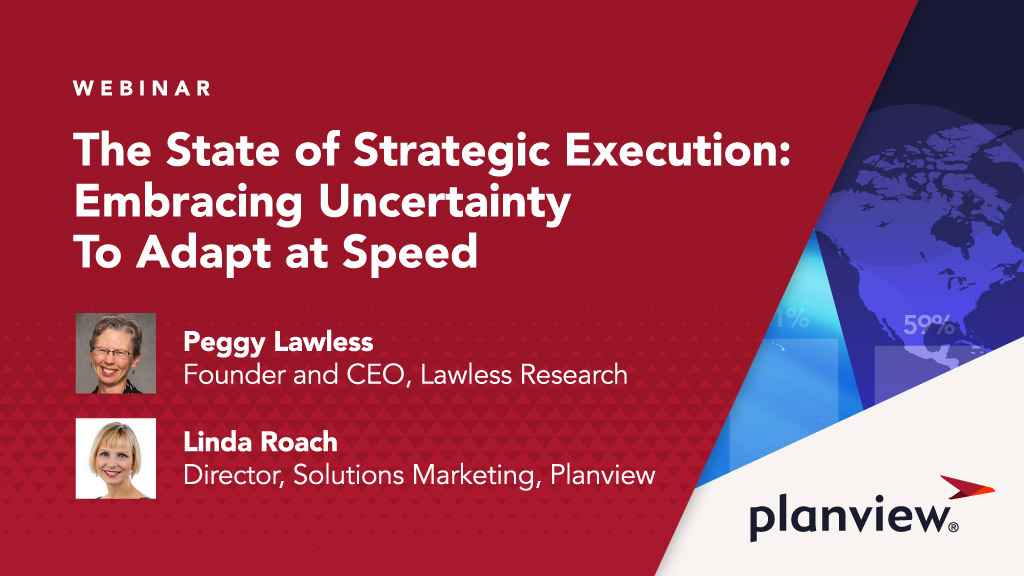
Is your organization able to maintain an effective strategy under uncertainty?
In today’s economic landscape marked by financial instability and disruption, it’s never been more critical for organizations to become adaptable to survive. Strategic portfolio management (SPM) can give your organization the much-needed agility and up-to-date data to pivot when priorities and strategy shift.
Using SPM can help you develop an effective strategy under uncertainty that carries your enterprise forward. You can empower your enterprise to weather economic instability, market volatility, disruptive technology, and evolving customer preferences.
Let’s dive into the benefits of strategic portfolio management and how you can advocate for it within your organization.
How SPM Empowers Your Organization to Drive Value
In today’s world, the only constant is change. Creating a forward-focused strategy and staying ahead of the curve can help your company thrive in an uncertain future.
Strategic portfolio management enables your enterprise to connect work across portfolios to the company strategy, and keep it connected even when priorities shift. This empowers your organization to make better-informed investment decisions and maintain an effective strategy under uncertainty.
And when strategy changes, up-to-date data makes you better equipped to adapt the planning and funding accordingly.
You can use SPM to:
- Pivot easier during disruptions
- Prioritize outcomes that align with company strategy
- Identify new growth opportunities
- Ensure your delivery stays informed by organizational strategy
Weathering economic uncertainty with SPM
Your organization can benefit from strategic portfolio management, regardless of whether you’re faced with market volatility or experiencing economic growth.
With that said, the benefits for SPM can be especially valuable during economic uncertainty, when organizations need the agility to quickly adapt to change.
Access to real-time data allows you to easily check the performance of your portfolios and determine whether you’re investing money and resources into work that aligns with your overall business strategy. That knowledge can act as a catalyst to create a more strategic and agile organization.
How else can you become a more adaptable organization that drives strategy under uncertainty?
- Change how you plan: Moving your organization from annual to continuous planning enables you to pivot quickly when faced with disruptions. Staying agile helps ensure your portfolio and investments align with your company’s strategies and goals – and stay aligned even when your strategy and goals change.
- Focus on outcomes, not outputs: The work you invest in should focus on achieving business outcomes that align with the company strategy. This is especially important during economic uncertainty because companies have to invest in work that matters. Outputs are still important, but the bigger picture is even more critical. Focus on work that aligns with your company goals and objectives.
- Adopt the right technological ecosystems: Organizations need the right solution to enable adaptive strategy under uncertainty. Solutions should support agile and hybrid work, give top-down visibility into projects, and provide project leaders and stakeholders with valuable up-to-date data so they can make better-informed decisions.
Overcoming Barriers That Undermine Organizational Adaptability
Two of the most challenging barriers to your organization’s adaptability are overly complex governance and non-integrated tech solutions that don’t offer big-picture data.
In normal circumstances, these undermine your ability to drive innovation and stay competitive. But during fast-paced change and uncertainty, these issues can seriously inhibit your company’s success.
Strategic portfolio management allows organizations to address these pain points and ensure they’re investing in the right projects to drive the company forward.
With economic uncertainty looming, many companies are cutting spending and tightening their purse strings. Ensuring your strategy and delivery are connected means your organization is making better-informed investment decisions.
Your organization needs an adaptable strategy under uncertainty that empowers them to drive business value while weathering disruption. But that requires investing in a solution that increases visibility and provides stakeholders with up-to-date data about the performance of their portfolios.
Now that we touched on the benefits of SPM, let’s look at how you can get executive buy-in.
Advocating for SPM in Your Organization
Understanding the benefits of SPM is only half the battle – you also have to know how to advocate for it. That requires you to understand the needs and concerns of your organization’s key decision-makers.
Change is scary. Companies following traditional planning cycles may be especially reluctant to change amid fears of an economic downturn. Still, SPM is crucial to helping companies drive strategy under uncertainty and ensure their investments go towards initiatives that matter.
Advocating for SPM starts by addressing what your organization needs in the face of change and economic uncertainty. Common business needs include the following:
- A balance of stability and adaptability
- Organizational agility to adapt to change alongside economic conditions, tech disruption, and changing customer preferences
- A willingness to evolve to unlock new growth opportunities
- An understanding of executive needs and concerns
Addressing these issues while advocating for SPM will increase your chances of obtaining executive support.
Become an Adaptive Enabler within Your Organization
The world is changing, and your enterprise needs to evolve alongside it. SPM can help your organization drive value, uncover new opportunities, and thrive even during economic uncertainty.
Learn how your enterprise can benefit from SPM and how you can advocate for it by addressing executives’ big-picture questions and top-of-mind concerns. Access our eBook titled Align, Adapt, and Transform with Strategic Portfolio Management to start your strategic journey.




